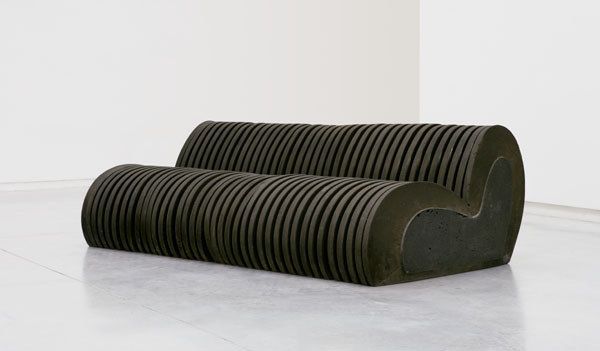CINI BOERI: 70s design
- Biography:
Maria Cristina Mariani Dameno - called Cini by the family because
it is the diminutive of "picinin" (little name in Milanese
dialect) - was born in 1924 and devoted great attention to the
study of the functionality of space and to the psychological
relatioships between man and the environment
Strong supporter of the client and user freedom of behaviour,
she has always used the concepts of expandability and flexibility
in her work, combined with the experimentation of new materials.
The creative contribution made to the world of industrial design
earned her the award of the Compasso d'Oro.
- Famous workmates:
Cini Boeri practiced for a few months with Gio Ponti,
in his studio in via Dezza, where she received his first work
table. Ponti, however, stimulated her more to paint than
practising architecture. He attributed her a good sensitivity
to colors. Ponti taught her to have a certain order in the
design process and a mental and physical order. While she was setting up at the Salone del Mobile
she was approached by Marco Zanuso, who almost immediately
offered her to work in his studio. She worked with him for
12 years, during which time she approached each project with
attention to the clients psychology, a practical verification
of everything that she would then propose and she also learned to self-criticize. On the advice of Franca Helg,
Zanuso's collaborator, Cini left his studio to open one of her own before becoming an indissoluble
member of the Zanuso studio.
- Philosopy:
Design For Cini Boeri, being an architect and designer is one and the same. Acccording to her, the relationship between
inhabitants and objects is constant and it is precisely from here that her interest in design and for
everything that is used in relation to a space. Several times in interviews she emphasizes the
difference between today and the 1950s, you argue that "design" meant designing elements from
mass production, control over suitable materials and the method of its production; all for the purpose
to make their cost accessible to a wide range of the public. There are many examples of this
products that she has designed, such as the Borgogna and Bobo armchair, the Gradual sofa and the tube lamps.
inhabitants and objects is constant and it is precisely from here that her interest in design and for
everything that is used in relation to a space. Several times in interviews she emphasizes the
difference between today and the 1950s, you argue that "design" meant designing elements from
mass production, control over suitable materials and the method of its production; all for the purpose
to make their cost accessible to a wide range of the public. There are many examples of this
products that she has designed, such as the Borgogna and Bobo armchair, the Gradual sofa and the tube lamps.
The very famous Serpentone, a seat that is the result of his search for elements that were needed
live simply. By studying polyurethane foams, innovative for the time, in six months of
design with tight tests, an infinite session emerged to be cut and sold by the meter, a
kilometres. Flexible in the desired shape, concave or convex curves with radii of one, two or
three meters as needed. It was a poor material, used with the same finish obtained
when it comes out of the mold. He introduced it to Artflex and everyone was thrilled.
live simply. By studying polyurethane foams, innovative for the time, in six months of
design with tight tests, an infinite session emerged to be cut and sold by the meter, a
kilometres. Flexible in the desired shape, concave or convex curves with radii of one, two or
three meters as needed. It was a poor material, used with the same finish obtained
when it comes out of the mold. He introduced it to Artflex and everyone was thrilled.
- The greatest satisfaction
Inspired by Christo who begun to pack monuments from around the world in the
sixties, Cini came up with the idea of packing a sofa and the first series of Strips from 1971 was born.
- Her work of art
The Ghost seat was an ironic response to the constant request
for new seats, despite the fact that the range of sofas and
armchairs on the market was already wide. Her intent was to
produce an invisible chair, she wanted it to be transparent.
From a single sheet of glass, folded and cut according to
a precise design, the first Ghost was born. Almost considered
to be a piece of art It gained a huge success.



0 Comments
There are no comments yet. Be the first one to post one!